As eyesight helps individuals sense and absorb information from their surroundings, it is an essential aspect of overall health and well-being. Consquently, health professionals strongly advise wearing sunglasses to protect one’s eyesight from sun damage. As explained in the previously linked post, ultraviolet radiation from the sun can compromise vision health and increase the risk of eye conditions like iris damage and cataract formation.
But besides sunglasses, another type of eyewear that helps maintain optimal eye health is a pair of prescription glasses. Amid the rising prevalence of vision impairments like myopia (nearsightedness), hyperopia (farsightedness), and astigmatism in the UK and worldwide, glasses enhance visual acuity and help prevent the progression of these conditions.
Although glasses are the most common and widely accessible, other eyewear options have emerged to expand options for vision correction. So, let’s take a look at how prescription sunglasses and contact lenses address the disadvantages of wearing glasses and help individuals achieve proper eyesight in daily life.
The problem with wearing glasses
Since prescription glasses are the most common form of corrective treatment for vision problems, eyewear manufacturers have been working to broaden the range of frame styles and price points — making them more suitable and affordable to global consumers.
However, glasses wearers still encounter challenges, such as the lenses not being able to reduce glare and therefore compromising safety when outdoors or on the road. As such, companies like Essilor have developed anti-glare coatings like Crizal Drive, which aids drivers in lower light conditions. Yet these features could be more budget-friendly since consumers can only get them at an additional cost.
While glasses are easy to wear and maintain, another disadvantage is that their lenses are vulnerable to scratches and overall damage. So, vision-impaired individuals usually have to remove their glasses and sacrifice visual clarity when engaging in sports and outdoor activities. Fortunately, these barriers are taken care of by other corrective options, as discussed below.
Benefits of prescription sunglasses
Compared to a regular pair of sunglasses, prescription sunglasses serve a dual purpose: they shield the eyes from the sun and simultaneously correct one’s vision based on their eye grade. This also makes them a budget-friendly solution, as eyewear retailer Glasses Direct explains that consumers can get both sun safety and vision enhancement by simply adding £15 sunglasses tints to any frame.
Besides not needing additional coatings or separate pairs of eyewear for outdoor and indoor use, options for prescription sunglasses are also widely varied. Glasses Direct offers both affordable and luxury brands to cater to consumers, whether they need in-house frames below £50 or are looking to splurge on stylish sunglasses from Oakley and Ray-Ban. Frames are also available in various frame sizes, shapes like oval and cat-eye, and materials like metal and acetate — all while being compatible with single-vision, bifocal, and multifocal prescriptions.
Benefits of contact lenses
On the other hand, contact lenses are also a viable alternative to eyeglasses due to their ease of use and convenience. To start, they sit directly on the surface of the eyes, providing an uncompromised field of view and peripheral vision. Compared to glasses, they are also less likely to fall off or get damaged, even when the wearer uses them for recreational outdoor activities.
Additionally, contact lenses are now designed in more complex shapes and prescriptions to suit the wearer’s specific vision and comfort needs. Menicon is preparing to launch a specially tailored soft contact lens design, which considers corneal curvature and diameter together to fit every eye more comfortably. These lenses are available in different curvature-diameter sizes and in monthly packs.
Overall, both prescription sunglasses and contact lenses provide individuals in need of corrective eyewear with more options, thereby helping improve not only their vision but overall quality of life.








